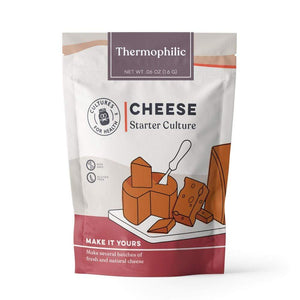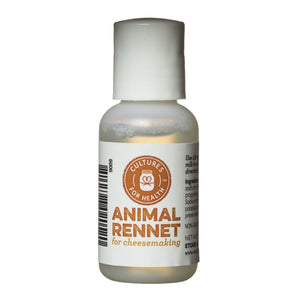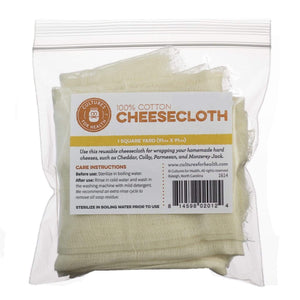
Swiss cheese is well known for its pockets of air, created during the culturing process by the active propionibacteria.
30 minutes
48 minutes
4
INGREDIENTS AND EQUIPMENT AVAILABLE AT CULTURES FOR HEALTH
Fresh Cheese Making Kit
Propionibacteria Cheese Starter Culture
Thermophilic Starter Culture

Thermophilic Starter Culture
$12.99
This useful culture makes a variety of hard cheeses, including parmesan, romano, provolone, and swiss.
Thermophilic B Culture
Liquid Animal Rennet

Liquid Animal Rennet
$12.99
High quality single strength animal rennet. This non-GMO animal rennet is preferred for aged cheese as it creates a more desirable flavor and aroma during the aging process. Each bottle contains enough rennet to set (12) 2-gallon batches of cheese.
Vegetable Rennet Tablets
Stick On Thermometer Strip

Stick On Thermometer Strip
$1.99
A stick on thermometer is a hassle-free way to keep an eye on the temperature of your ferments. Apply a thermometer sticker to your kombucha fermentation bottle or your yogurt culturing container and always know that you're within the safe range.
Strip thermometers are flexible, unbreakable, and self-adhesive for easy use.
Cheesecloth

Cheesecloth
$7.99
A looser weave than our butter muslin, this 100% cotton cheesecloth is great for wrapping cheeses and draining whey from all sorts of cultured foods.
EQUIPMENT:
- Large pot
- Digital Thermometer
- Long knife (curd knife; does not need to be sharp)
- Cheesecloth (2 pieces)
- Cheese press
- Wire whisk
INGREDIENTS:
- 2 gallons fresh milk from cows, goats, or both
- 1/8 tsp. propionibacteria, dissolved in 1/2 cup milk
-
Starter Culture (choose one):
- 1 packet direct-set thermophilic culture
- 1/8 tsp. bulk thermophilic culture
- Thermo B Culture
-
Rennet (choose one):
- 1/2 tsp. liquid animal rennet, dissolved in 1/2 cup cool water
- 1/4 tsp. double-strength liquid vegetable rennet, dissolved in 1/2 cup cool water
- 1/4 vegetable rennet tablet, dissolved in 1/2 cup cool water
- 2 Lbs. sea salt (non-iodized) or cheese salt
- 1 gallon water
- Olive oil
INSTRUCTIONS:
- Heat the milk to 87°F. Add the thermophilic culture and stir well. Add propionibacteria and stir for at least 1 minute. Cover and allow to ferment for 15 minutes.
- Check temperature and make sure milk is no warmer than 90°F. Stir to homogenize the milk, and slowly fold in the diluted rennet. Using an up-and-down motion with your spoon will ensure that the rennet works its way through all the milk, so you can get the highest possible yield.
- Allow the cheese to set for 30 to 45 minutes at 90°F, or until the whey begins to separate from the curd. You should see a layer of mostly clear whey floating on top of the curd, and the curd should be pulling away from the sides of the pot.
- Using a long knife, cut the curds into 1/4-inch cubes.
- Stir the curd with a whisk, slicing it into small pieces. The pieces should all be roughly the same size.
- Keep the curds at 90°F and stir with the wooden spoon, working out the whey, for 35 minutes.
- Over the next 25 minutes, slowly heat the curds to 120°F, stirring frequently with your wooden spoon. As you stir, the curds will shrink. Keep the curds at 120°F for 30 minutes. The curds should be small, and if you bite one it should squeak in your teeth. A handful of curds, squeezed into a ball, should fall apart in your hands.
- Pour the curds-and-whey through a strainer, capturing the whey in a bowl to save for future projects (or you can discard it).
- Pour the curds into a press lined with cheesecloth. Work quickly; you do not want your curds to cool. Press at 10 pounds of pressure for 15 minutes.
- Using a fresh piece of cheesecloth, flip the cheese and press, again, at 15 pounds of pressure for 30 minutes.
- Repeat this process again, at 15 pounds of pressure for 2 hours, rinsing the cheesecloth in clean, cool water each time and hanging to dry.
- Finally, press at 20 pounds of pressure for 12 hours, or overnight.
- Mix 2 pounds of sea salt with 1 gallon of cold water to make a brine. Place the cheese in the brine and let it soak for 24 hours.
- Take the cheese out of the brine and age at 55° to 60°F for one week. Flip and wipe daily with a damp cheesecloth dipped in salt water.
- Age the cheese in the kitchen (or another warm room) for 2 to 3 weeks. Flip and wipe daily with a damp cheesecloth dipped in salt water. The cheese should swell and will have a characteristic Swiss cheese smell.
-
Place the cheese in your aging refrigerator or cheese cave for 12 weeks or more. (Click here for practical methods for aging cheese.) Flip once or twice a week and remove mold with a cheesecloth dipped in salt water.
















